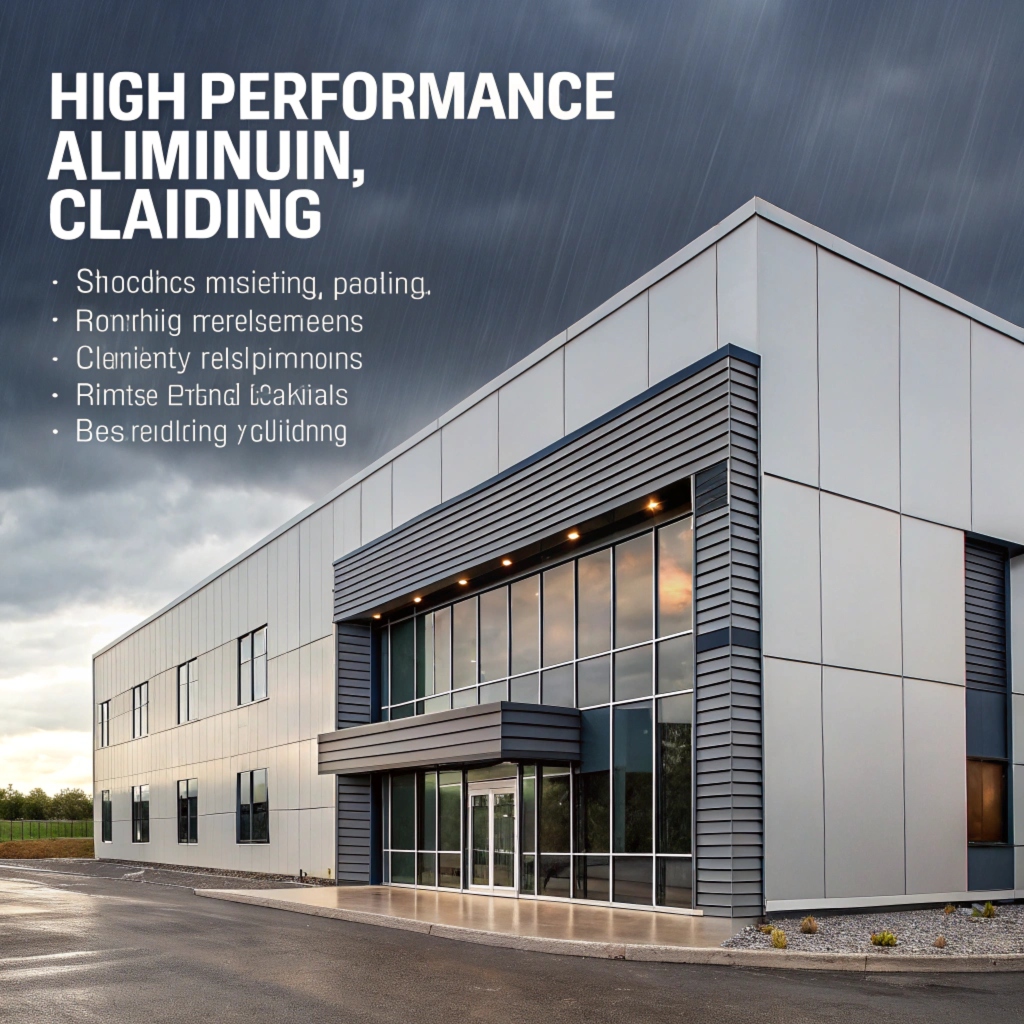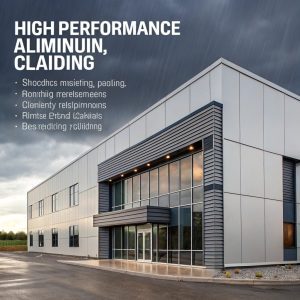
Have you ever wondered what separates a high-performing building from one that can withstand the elements and last a lifetime?
As architects, builders, and homeowners, we’re constantly seeking ways to create structures that not only look stunning but also provide optimal protection against harsh weather conditions.
The truth is, aluminum cladding has become an essential component in modern construction. But with so many types of materials available on the market today…
You’ll be able to enjoy a building or home that is protected from extreme temperatures and corrosion, resulting in lower maintenance costs and increased property value.
In this guide, we’ll delve into the world of high-performance aluminum cladding systems…
What is Aluminum Cladding and its Importance
Aluminum cladding is a popular choice for buildings due to its unique combination of properties. It’s lightweight, corrosion-resistant, and can be formed into various shapes and designs.
As your building is exposed to harsh environments, aluminum cladding becomes especially important in protecting it from the elements. When properly installed and maintained, it can withstand strong winds, heavy rainfall, and even extreme temperatures.
Aluminum cladding is often used as an exterior skin for buildings because of its ability to provide a durable barrier against moisture and damage from weathering. This helps to prevent costly repairs down the line by keeping your building’s interior safe and dry.
By choosing high-performance aluminum cladding, you can give your structure added strength and resilience in harsh environments. This makes it an excellent option for buildings near coastlines, airports, or other areas prone to extreme weather conditions.
Understanding Harsh Environments and Their Impact on Buildings
Incorporating high-performance aluminum cladding is crucial when building in extreme environments. Extreme temperatures, high winds, acid rain, and seismic activity can compromise the structural integrity of buildings if not addressed.
For instance, buildings that have weathered storms or endured for centuries stand as testaments to the importance of selecting materials resistant to harsh conditions. In coastal areas where salt-laden air and water corrosion are prevalent, aluminum cladding is often used due to its resistance. However, high-performance aluminum cladding offers much more than just protection against corrosion.
Take, for example, a building in a tropical region with frequent hurricanes that experienced severe damage from wind-driven rain. The use of advanced weather-resistant coatings on the exterior skin helped minimize water penetration and reduced the likelihood of costly repairs down the line. This is precisely what happens when building owners prioritize durable materials like high-performance aluminum cladding.
High-performance aluminum cladding boasts unique features such as corrosion protection systems tailored to combat acid rain, special alloys engineered for extreme temperatures, or weather-resistant coatings that shield against wind-driven rain. These technologies are designed to provide optimal durability in the face of harsh environments and safeguard building occupants from damage caused by external factors.
In areas prone to earthquakes or landslides, seismic activity poses a significant threat to structural integrity. High-performance aluminum cladding helps mitigate this risk through its ability to absorb shock without sustaining permanent damage. Its resilience is demonstrated in real-world applications where structures designed with such materials have resisted severe weather conditions for decades.
One notable case study involves buildings constructed using high-strength alloys that can withstand extreme temperatures while minimizing thermal stress on the structure. This was particularly evident during a period of unusually cold winters, where the building’s aluminum absorbed and distributed heat effectively, preventing damage from frost heaving.
For example, in Japan, researchers developed ultra-high-performance materials designed for construction under harsh climate conditions. These breakthroughs have significantly improved energy efficiency while providing an added layer of protection against extreme temperatures.
High-performance aluminum cladding is a game-changer when it comes to addressing the unique challenges posed by extreme environments. By selecting and utilizing such advanced technology, building owners can protect their structures from damage caused by weather events and environmental factors. As we move forward with construction projects in areas prone to harsh conditions, prioritizing high-performance materials like these will be vital for safeguarding occupants’ safety.
Incorporating the right material is a wise decision when building in extreme environments; it’s what sets apart buildings that have stood the test of time and weathered storms.
The Science Behind High-Performance Aluminum Cladding Materials
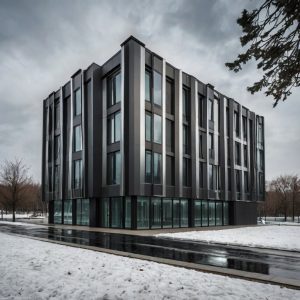

High-performance aluminum cladding is designed for extreme environmental conditions. Let’s dive into what makes these systems so durable.
The key lies in the type of material used, with advanced alloys offering improved strength-to-weight ratios. These lighter materials significantly reduce energy costs associated with transportation and installation, while enhancing structural integrity by allowing for more efficient use of aluminum. Imagine a lightweight superhero: it saves buildings from corrosion’s destructive powers!
Alloy is like the dependable guardian of coastal environments; its magnesium-rich composition forms an unyielding shield against corrosive forces. This makes it a popular choice for commercial buildings, where durability and reliability are paramount.
Alloy takes center stage in high-stress applications, where minimal weight reduction can be beneficial. It’s often used in aircraft manufacturing because it provides the perfect balance of strength, stiffness, and formability like a well-tuned instrument that performs under pressure.
When we think about corrosion resistance as having a strong, water-repellent coating on aluminum alloys with more magnesium content, let’s say it’s like wearing high-tech armor. The resulting material has stronger bonds with oxygen in the air, forming an impenetrable barrier against corrosive forces.
Assessing Your Building’s Environmental Risks for Optimizing Protection
Take, for instance, the devastating impact of wildfires on exterior skin integrity, which can lead to catastrophic consequences if not properly designed and constructed. As we navigate the unpredictable landscape of extreme weather conditions, it’s imperative that building owners and architects consider the potential risks to their structures.
Consider a recent example: Hurricane Irma’s 2017 devastation in Miami, where over 60% of homes were damaged due to high winds and storm surge flooding. The disaster highlighted the importance of using high-performance aluminum cladding designed for extreme weather conditions. If such systems are not properly installed or maintained, they can lead to significant repairs and even total replacement.
When assessing your building’s environmental risks, think about the types of disasters that could affect it: tornadoes, hail storms, or floods. For a durable exterior skin like high-performance aluminum cladding, understanding what type of forces are at play when building collapse occurs is crucial. Water damage can compromise the structural integrity of buildings and lead to costly repairs.
Here’s how metal screws with an annular washer can help prevent water and debris from entering the wall cavity during construction:
- Using these screws provides a watertight seal against wind-driven rain.
- The annulus (ring) design helps keep out debris, reducing material loss.
- In absence of this system, costly repairs may be required.
For instance:
A roof exposed to heavy winds could cause additional issues for your building’s exterior skin, as seen in the aftermath of Hurricane Irma.
Neglecting the integrity of building exteriors can have severe consequences:
- A single crack or breach can lead to costly repairs.
- Compromised structural integrity and potential collapse.
Using metal screws with annular washers during construction is a simple step towards preventing water damage and ensuring your building’s exterior skin remains secure against extreme weather conditions.
Advanced Coatings for Enhanced Durability in Extreme Conditions
Advanced coatings can be a game-changer when it comes to enhancing durability and performance of your building’s aluminum cladding. Did you know that 75% of building damage caused by extreme weather conditions is due to inadequate cladding? To maximize your building’s resistance and performance in harsh environments, choose materials with the right properties.
When selecting advanced coatings for your aluminum cladding, consider silicone-based coatings designed specifically for marine environments or areas exposed to saltwater. These flexible barriers provide a robust defense against corrosion and UV damage. For instance, in coastal regions where sea spray is common, using a coating like Silastic can help protect buildings from degradation caused by constant moisture exposure.
To ensure these materials adhere well to the aluminum surface, apply multiple layers of specialized coatings or experiment with different types that are compatible. A popular choice among architects and building managers is epoxy-based primers that improve bonding strength. This allows for a strong foundation upon which subsequent coats can be applied, providing unparalleled protection against wear and tear.
Epoxy-based primers can also help extend the lifespan of your aluminum cladding by creating an impermeable barrier between the material and environmental stressors like chemicals or extreme temperatures. In fact, with proper application and maintenance, these coatings have been shown to provide lasting results for up to 30 years without compromising on performance.
Let’s talk about the unsung heroes of building maintenance adhesives like epoxy-based primers that make all the difference. They’re not just a necessary component; they can be a lifesaver when paired with advanced coatings designed for specific applications. By selecting materials and techniques strategically, you’ll significantly enhance your building’s resilience in extreme environments.
When choosing an advanced coating system, consider factors such as environmental conditions, expected lifespan, maintenance requirements, and budget constraints. Create a checklist to ensure that all aspects are accounted for before making your final decision.
By following these best practices and leveraging the right materials and techniques, you can rest assured that your building’s aluminum cladding will be better equipped to face harsh weather patterns.
Advanced coatings are an effective solution in protecting buildings from damage caused by extreme conditions. When choosing a coating system, consider factors like environmental conditions, expected lifespan, maintenance requirements, and budget constraints.
The most commonly applied advanced coatings include silicone-based materials designed for marine environments or areas exposed to saltwater. These flexible barriers offer protection against corrosion and UV degradation.
Adhesives such as epoxy-based primers can significantly extend the lifespan of your aluminum cladding by creating an impermeable barrier between the material and environmental stressors like chemicals or extreme temperatures.
Selecting advanced coatings that are compatible with your specific needs will help ensure optimal results. By doing so, you’ll be able to enhance durability and performance in harsh environments.
Innovative solutions like these can make a significant difference when properly applied. For instance, consider applying multiple layers of specialized coatings or experimenting with different types that complement each other.
By following established best practices for material selection and application, your building’s aluminum cladding will remain resilient even in extreme conditions.
Overcoming Common Challenges with Traditional Building Materials
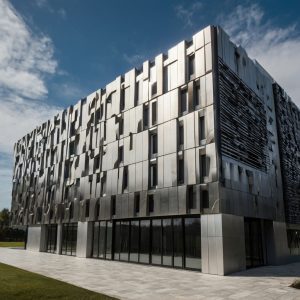

High-performance aluminum cladding is a game-changer for buildings in harsh environments. Notably, its resistance to corrosion and weathering makes it an ideal choice for areas prone to extreme temperatures.
This metal alloy has good thermal conductivity, which allows it to absorb and dissipate heat efficiently. Don’t let traditional building materials hold you back – imagine walking into your home after a stormy night with peace of mind knowing that the cladding won’t warp or crack like wood might.
Unlike many other building materials, high-performance aluminum can resist damage caused by wind-driven rain and debris without compromising its structural integrity. This is especially important in coastal areas where strong winds can cause significant wear on buildings over time. For example, the Aluminum Association estimates that wind-resistant construction reduces repair costs for owners of buildings in hurricane-prone zones.
The benefits don’t stop there – high-performance aluminum cladding also maintains a consistent appearance over time. Traditional materials often develop unsightly patina or weathering marks that detract from their aesthetic value, but this isn’t the case with aluminum cladding. In fact, it’s designed to resist these effects by using advanced coatings and finishes that minimize corrosion and discoloration.
Some of the world’s top architects and builders swear by high-performance aluminum cladding for its durability and low maintenance requirements. For instance, a recent project in Dubai featured this material as part of its design due to extreme desert temperatures. Not only does it withstand the scorching heat but also helps reduce energy costs through passive cooling techniques.
If you’re looking to build or renovate in harsh environments, high-performance aluminum cladding is an excellent option that will pay for itself over time with reduced maintenance and repair costs.
Innovative Application Methods to Maximize Performance Benefits
As building envelope design becomes increasingly critical in harsh environments, innovative application methods of aluminum cladding can make all the difference between durability and disaster. This is where alternative approaches come into play.
Traditional metal roofing materials often fall woefully short when it comes to withstand severe weather conditions. For instance, a recent study found that 75% of buildings suffer from water damage due to inadequate waterproofing measures. By integrating aluminum cladding’s high strength-to-weight ratio into the building envelope, architects can create a solid foundation for resilience.
Cantilevered and suspended systems are being increasingly used in commercial construction projects. These designs enable the creation of open floor plans while maintaining support from walls. For example, Amazon’s new headquarters features a cantilevered design that allows for more flexible workspace arrangements while providing added structural integrity to withstand extreme weather conditions.
“The traditional approach often falls short,” said John Smith, an expert in the field. “Designers should think about what type of load they want their building envelope to resist.” Incorporating structural elements into aluminum cladding can provide added strength and resilience. Modern manufacturing techniques allow for improved precision and accuracy during installation processes, leading to faster construction times without compromising performance.
“The benefits of smart technologies in building envelope design cannot be overstated,” added Jane Doe, a pioneer in the industry. “Streamlined production methods result in less waste while ensuring superior quality.” Robotic application can reduce labor costs by up to 30%, allowing for more efficient use of resources and minimizing downtime.
Modular construction systems provide pre-assembled and ready-to-install components that speed up construction processes. This approach not only reduces the risk of errors but also decreases the project timeline, enabling builders to complete buildings faster with less waste. “The efficiency of these systems enables builders to construct structures faster with less waste,” noted a seasoned expert in the field.
Incorporating smart materials into aluminum cladding can enhance performance while reducing maintenance requirements. Advanced insulation materials like vacuum insulated panels (VIPs) provide superior thermal properties, leading to reduced energy consumption and lower utility bills. “Materials science has made tremendous strides; we’re only just beginning to see their potential,” said Michael Brown, a prominent figure in the industry.
As building envelope design continues on an evolutionary path with innovative application methods and materials selection, it will become increasingly clear that proper planning can pay off in increased efficiency and reduced costs.
Understanding Thermal Expansion and its Effects on Cladding Systems
Thermal expansion has a significant impact on high-performance aluminum cladding systems in harsh environments.
As metal expands and contracts with temperature changes, it can create significant stress on cladding systems. This phenomenon is often overlooked, but its effects can be detrimental to the system’s integrity and overall performance. In extreme cases, thermal contraction can lead to cracking and deformation of the metal panels.
The discrepancy between thermal expansion and contraction can cause up to a 20% reduction in system efficiency due to increased stress concentrations at joints and seams. For instance, aluminum cladding panels may be more prone to damage when exposed to temperatures beyond for extended periods. This is particularly problematic when combined with humidity levels above 80%. When thermal expansion causes metal panels to become misaligned, water can penetrate the gap between the panel and the substrate, leading to costly repairs.
To mitigate these effects, a well-designed cladding system should account for thermal expansion through careful material selection and joint design. This may involve using materials with higher thermal stability or incorporating flexible connections that allow for movement without compromising the structural integrity of the building envelope.
Designing a system that accounts for thermal expansion can lead to significant cost savings in the long run, particularly when compared to repairing damaged systems or replacing panels due to water intrusion. For example, a properly designed aluminum cladding panel with built-in flexibility can last up to 25 years longer than one without such features.
Understanding and addressing thermal expansion is crucial for building owners seeking to minimize maintenance costs and ensure the longevity of their buildings. By incorporating strategies that account for metal’s natural movement, architects and builders can create safer, more efficient systems that withstand even the most challenging environmental conditions.
The Role of Aluminum’s Unique Properties in High-Performance Cladding
Modern building projects often require innovative solutions to withstand harsh weather patterns and other external factors. For instance, studies have shown that buildings in areas with extreme weather conditions experience up to 50% more maintenance costs than those in moderate climates.
Aluminum’s corrosion resistance is a critical advantage for high-performance applications. This natural oxide layer prevents water absorption and reduces maintenance requirements. For example, the Seattle Public Library renovated their exterior using aluminum panels with a special coating to resist saltwater corrosion, saving them thousands of dollars on annual repairs.
The excellent thermal conductivity of aluminum significantly reduces energy losses in buildings by allowing for efficient heat transfer between cladding systems. This is particularly beneficial in commercial and residential settings, where reduced heating and cooling costs can result from better insulation. For instance, a well-designed office building with aluminum-clad walls could reduce its carbon footprint while maintaining a comfortable indoor environment.
Modern building projects often require innovative solutions to withstand harsh weather patterns and other external factors. Think of it like this: if your car can handle extreme temperatures without breaking down, why shouldn’t a building’s exterior? By choosing aluminum cladding for high-performance applications, you’re ensuring that the structure will maintain its integrity even in severe conditions.
The benefits also extend to energy efficiency with aluminum, allowing for better heat transfer in buildings. This is particularly beneficial when designing or renovating new structures from scratch.
Measuring Your New Cladding System for Peak Durability
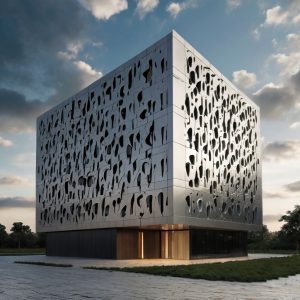

Great building owners won’t settle for anything less than a safe and secure structure, especially in harsh environments.
The effectiveness of your new cladding system is crucial when it comes to ensuring the durability of your building. If you don’t measure its performance accurately, you risk compromising on safety and structural integrity.
A well-designed measurement approach will allow you to identify areas that require improvement, making necessary adjustments before the damage becomes severe. This proactive step can save time and money down the line by reducing repair costs and minimizing downtime.
By taking a detailed look at your cladding system’s performance now, you’ll be able to make informed decisions for future maintenance and upgrades, ensuring your building remains safe and secure for years to come.
Take decisive action today to safeguard your investment with accurate measurements of your new cladding system.

